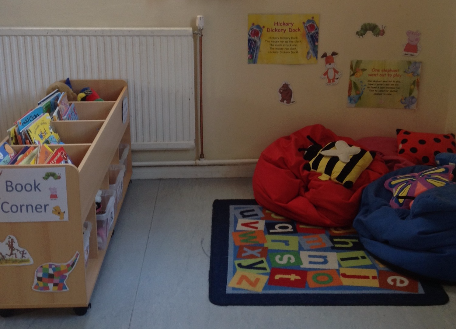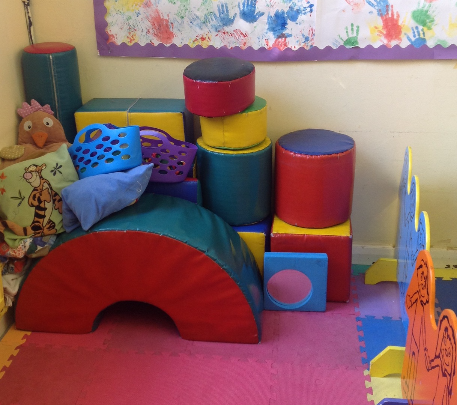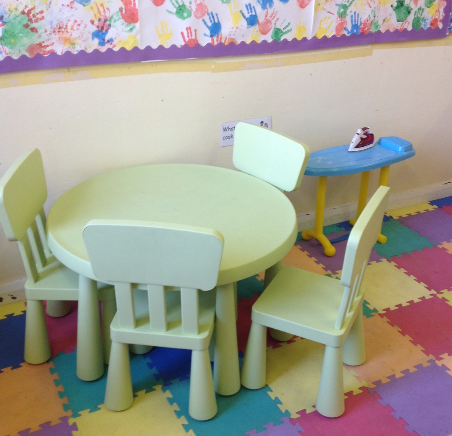Play and learning
The Early Years Foundation Stage (EYFS) areas of learning and development have been produced by the Government and early years professionals for use by all early year providers.
We use the areas of learning and development when we are observing, assessing and planning for your child’s individual needs to make sure that we are constantly challenging your child and helping them to develop and succeed.
There are 7 areas of learning and they are split into 2 parts:
- The 3 prime areas which are for all children but will be the main focus for children under three
- The 4 specific areas which are mostly used for the over threes but are also relevant for younger children.
These are the 3 prime areas:
|
Personal, social and emotional development |
This area of learning and development is about how your child:
|
|
Physical development |
This area of learning and development is about how your child:
|
|
Communication and language |
This area of learning and development is about how your child:
|
These are the 4 specific areas:
|
Literacy |
This area of learning and development is about how your child:
|
|
Mathematics |
This area of learning and development is about how your child:
|
|
Understanding the world |
This area of learning and development is about how your child:
|
|
Expressive Arts and Design |
This area of learning and development is about how your child:
|
When planning activities for the children to undertake to meet these development areas we take into account the Characteristics of Effective Learning and we give opportunities for the following:
- Playing and Exploring – Engagement
Children will get the chance to play with what they know, explore and find out about new experiences and they will always be encouraged to ‘have a go’ and enjoy new challenges
- Active Learning – Motivation
We will encourage children to be involved fully in all activities and concentrate as necessary. We will always encourage children to keep trying and enjoy achieving new goals.
- Creating and Thinking Critically – Thinking
We will encourage children to have their own ideas and incorporate them into their play, whilst making links between different aspects of their lives and choosing their own ways of how to achieve things.
If you want to find out more about the EYFS, the areas of learning and development, and characteristics of effective learning, all the documents we use can be found on this website which also has parents’ pages and contains lots of information
This is a link to a really useful guide to find out more about how your child is learning and developing during their first five years.
https://www.foundationyears.org.uk/files/2015/03/4Children_ParentsGuide_2015_WEB.pdf
Everyday activities provide a balanced and fun programme, including creative activities, number work, science and technology, music, singing, stories, baking, games, imaginative play, physical activities, and mark making. Older children will experience planned activities such as Circle Time, and Letters and Sounds.
We recognise that children learn and develop in different ways and at different rates. We value all areas of learning and development equally and recognise that they are inter- connected.
Observation, Assessment and Planning
Adults make ongoing observations and assessments of children’s learning, development and interests and use these to plan activities and provision to meet individual’s needs.
Observations are recorded in children’s Tapestry Online Learning Journals and an assessment made of them against the Development Matters. An overview sheet means a child’s progress can be tracked through the year.
Your child’s key person will meet with you on your child’s first day to complete a Starting Points record as a way of identifying your child’s stage of development, needs and interests.
Adults will complete a Two Year Progress Check on all children entering the setting aged two years. This is a statutory requirement of the EYFS. This check will be carried out after the child has been attending for several weeks, and will focus on the Prime Areas of Learning. The check will be shared with parents and discussed at a planned meeting. If your child has had a Two Year Progress Check in another setting, we will ask you to show us your copy.
Adults use observations made of their key children to plan for their individual learning and interests.
You will be invited to meet with their key person each term to discuss your child’s learning and development and plan for any next steps together.
In The Moment Planning
The cycle of observation, assessment& planning is carried out on a moment-by-moment basis which we call In the Moment Planning.
We have a workshop style environment both indoors and outside and the children are supported to select what they want to do (based on their learning and development needs) in each area.
The resources are accessible to the children and they are varied, open-ended and high quality. This gives children the opportunity to select resources to support their chosen activity. The adults are there to facilitate learning. through observations and interactions.
We have focus children each week and we invite their parents to share information about their interests and learning at home with us, using Tapestry Learning Journals. The focus children are given extra attention, but the other children are also pursuing their own learning, in the same environment, supported by the same adults.
Activities that occur are recorded daily and are added to the children’s Tapestry Learning Journals.
You will be invited to meet to discuss your child’s learning and development the week after they have been a Focus Child. This will happen once a term at least.
The Learning Environment
The setting is organised to allow children to explore and learn securely and safely. There are areas to be active or to be quiet. The environment is set up in areas of provision, where children can choose and access equipment and resources independently. The outdoor area offers opportunities for doing things in different ways and on a larger scale than inside. Children can experience changes in weather, opportunities for planting and growing and be physically active. We provide resources in the outdoor area to help children develop in all areas of learning.
When planning learning for the children to undertake to meet these development areas we take into account the Characteristics of Effective Learning and we give opportunities for the following: -
Playing and Exploring – Engagement
Children will get the chance to play with what they know, explore and find out about new experiences and they will always be encouraged to ‘have a go’ and enjoy new challenges
Active Learning – Motivation
The setting plans for children to be active learners by offering them physical and mental challenges, independence to make decisions, and learning experiences that are based on their individual interests
We will encourage children to be involved fully in all activities and concentrate as necessary. We will always encourage children to keep trying and hopefully they will enjoy achieving new goals.
Creativity and Critical Thinking
The setting plans for children to be creative through all areas of learning and recognises that creativity is not always about making an end product.
Adults support this by providing a stimulating environment with open-ended resources, allowing children time to try out ideas, and provide high quality experiences that promote imagination.
The setting aims to foster critical thinking skills in children. Adults support and encourage children to make connections between their thinking and learning by allowing time for reflection, asking open-ended questions and working alongside them to develop an idea or skill
We will also always take into account that each child is Unique and will learn in their own way. But to help them to do this we will build positive relationships not only with the child but with the parents and carers, and ensure that we offer a learning environment which is exciting and challenging.






